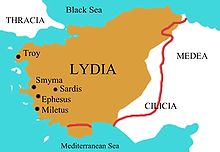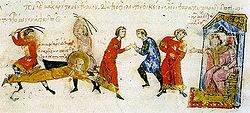- See of Sardis
-
The See of Sardis (or Sardes, Italian Sardi) was an episcopal see in Sardis. It was one of the Seven Churches of the Apocalypse, held by metropolitan bishops since the middle to late 1st century,[1] with jurisdiction over the province of Lydia (formed in 295). Since 1369 it was intermittently occupied by both Eastern Orthodox metropolitan bishops (until 1986) and Roman Catholic archbishops consecrated in partibus infidelium and later titular archbishops (until 1976).
Contents
History
After Diocletian reorganized the region in 295, Sardis became the capital of the district of Lydia, the seat of the governor and metropolitan archbishop.[2]
There is only one known epigraphic reference to the see of Sardis, published in the 5th or 6th century.[3] A 1959 landslide revealed several ecclesiastical artifacts and a throne that archaeologists postulated may have been used by the bishops of Sardis.[4] The first systemic investigation of the ruins of Sardis came in 1910 with an expedition from Princeton University.[1] Excavations in 1912 revealed a small "Church M", containing coins which were dated to the 5th century and an apse overhanging one of the earliest known Christian altars, near the north eastern corner of the Temple of Artemis.[1]
According to the Menologion, Clement, a disciple of Paul of Tarsus and one of the Seventy (Philippians 4:3), was the first bishop of Sardis.[1] Little is known about the ancient episcopacy of Sardis, with the notable exception of Saint Melito, a contemporary of Marcus Aurelius from the 2nd century,[5] whom some sources refer to as the second bishop of Sardis[6]—citing the "improbability of seventy years in the episcopate"[7]—making him the successor to the "angel of the church of Sardis" referenced in the New Testament (Rev. 3:1-3), while other sources regard Melito himself as the "apostle" or "angel of the church of Sardis."[8] In the Book of Revelation, Saint John writes a letter to the church of Sardis, reproaching it and its bishop.[9]
The Council of Rimini desposed Bishop Hortasius of Sardis in 359 because he had been ordained without the saction of the bishops of Lydia.[10] The See had 27 suffragan bishops (including the bishop of Thyatira[11] and Philadelphia[12][13]) in the 7th century, and approximately that number until the end of the 10th century.[9]
Arabs sacked Sardis in 716, but the city remained a part of a resurgent Roman (Byzantine) Empire until the aftermath of the battle of Manzikert in 1071. Euthymius, a Metropolitan Bishop of Sardis, was martyred in 824 in relation to iconoclasm.[14]
East-West schism
In 1118, Byzantine general Philocales recaptured Sardis from the Seljuk Sultanate of Rum. Andronikos, an Eastern Orthodox Bishop of Sardis circa 1283, made several attempts at East-West reunification.[9] Ottoman Turks captured Sardis in 1306; the city was destroyed by Timur in 1402.[15]
The Metropolitan of Sardis, which had once ranked sixth in precedence in the Eastern church,[9] continued to be appointed into the 13th century, long after Sardis had shrunk into a village which was no longer a regional locus of power.[16] In 1369, Philadelphia replaced Sardis as the site of the metropolitan bishop,[9] Sardis having been suppressed by the Patriarch of Constantinople,[17] and Roman Catholic archbishops of Sardis began to be consecrated in partibus infidelium (in a diocese which had fallen into the power of infidels) until 1882, when they were instead called titular archbishops.[9][18]
Dionysius, the Metropolitan of Sardis in 1438, died during the Council of Florence and thus was not made to sign its decree.[19]
Metropolitan Bishops
 Clement, a disciple of Paul the Apostle (pictured), attested to in Paul's Epistle to the Philippians is the first recorded bishop of Sardis.
Clement, a disciple of Paul the Apostle (pictured), attested to in Paul's Epistle to the Philippians is the first recorded bishop of Sardis.
One of the first scholarly listings of the bishops of Sardis is given by Michel Le Quien in Oriens christianus in quatuor patriarchatus digestus, in quo exhibentur Ecclesiae patriarchae caeterique praesules totius Orientis (abbreviated Oriens Christ.), published posthumously in 1740.[9]
- Clement (Philippians 4.3)[1]
- Melito of Sardis, circa 180[20]
- Hieromartyr Therapont of Sardis, circa 259[21]
- Heortasius (or Hortasius) (deposed in 359 by the Council of Ariminum)[10]
- Florentin (or Florentius), circa the 448 Synod of Constantinople[22][23][24]
- Hieromartyr Euthymius, circa 787—December 26, 824[9][14][25][26]
- John, successor of Euthymius[9]
- Peter, circa 835[27]
- Euthymios, 10th century[28]
Eastern Orthodox Metropolitans
- Andronikos (Latinized Andronicus), circa 1283—1315, deposed for being an Arsenite[29][30]
- Dionysius, circa the 1438 Council of Florence[31]
- Germanos Troianos, circa 1923[32]
- Maximos, 1946—1986[33][34]
Titular Archbishops
- Carlo Rossetti, circa 1641[35]
- Invitti, circa 1726[36]
- Binkentios Coressi (October 12, 1814 — March 7, 1835)[37]
- Stabilini (1831–1834)[38]
- Jean-Marie Mioland (April 2, 1849 — September 29, 1851)[37]
- Pietro Gianelli (April 5, 1858 — March 15, 1875)[37]
- Bernardino del Vago, circa 1879[39]
- Vicenzo Vannutelli (January 23, 1880 — June 23, 1890)[37]
- Salvatore Palmieri (December 14, 1891 — October 1, 1892)[37]
- Giulio Tonti (July 15, 1893 — October 1, 1894)[37]
- Benedetto Lorenzelli (November 30, 1896 — November 14, 1904)[37]
- Giuseppe Aversa (May 25, 1906 — April 12, 1917)[37]
- Eugenio Maria Giuseppe Giovanni Pacelli (April 20, 1917 — March 16, 1929)[37][40]
- Arthur Hinsley (January 9, 1930 — April 1, 1935)[37]
- Antonino Arata (July 11, 1935 — August 25, 1948)[37]
- Giovanni Urbani (November 27, 1948 — April 14, 1955)[37]
- Giuseppe Maria Sensi (May 21, 1955 — May 24, 1976)[37]
References
- ^ a b c d e Otto F. A. Meinardus. 1974. "The Christian Remains of the Seven Churches of the Apocalypse." The Biblical Acheaologist. Vol. 37, No. 3. p. 78–80.
- ^ Christian Churches of God. "The Pillars of Philadelphia." No. 283.
- ^ W.H. Buckler and David M. Robinson (eds.). 1932. Sardis, Vol. VII, Part 1, Greek and Latin Inscriptions. Publications of the American Society for the Excavation of Sardis. p. 190.
- ^ The New York Times. 1859, October 26. "Landslide yields Lydian artifacts." p. 3.
- ^ Philip Schaff. 1890. NPNF2-01. Eusebius Pamphilius: Church History, Life of Constantine, Oration in Praise of Constantine. New York: Christian Literature Publishing Co.
- ^ Steve Smith, 2005. "Saint Melito of Sardis: Early Church Father, Bishop, and Martyr."
- ^ Ernest Cushing Richardson et al. 1886. The Ante-Nicene Fathers: Translations of the Writings of the Fathers Down to A.D. 325. C. Scribner's Sons, p. 750.
- ^ Jeremy Taylor and Reginald Heber, 1828. The whole works of the Right Rev. Jeremy Taylor, D.D. Lord Bishop of Down, Connor, and Dromore: with A Life of the Author, and a critical examination of his writings by the Right Rev. Reginald Heber, D.D. late Lord Bishop of Calcutta. Reginald Heber. p. 35.
- ^ a b c d e f g h i
 "Sardes" in the 1913 Catholic Encyclopedia.
"Sardes" in the 1913 Catholic Encyclopedia. - ^ a b Sozomen et al., Edward Walford (trans.), 1855. The Ecclesiastical History of Sozomen: Comprising a History of the Church from A.D. 324 to A.D. 440. Henry G. Bohn. p. 191.
- ^
 "Thyatira" in the 1913 Catholic Encyclopedia.
"Thyatira" in the 1913 Catholic Encyclopedia. - ^ Ramsay, W. M. (1900). "Philadelphia". In James Hastings. A Dictionary of the Bible. III. pp. page 831. http://www.ccel.org/ccel/hastings/dictv3/Page_831.html.
- ^
 "Philadelphia" in the 1913 Catholic Encyclopedia.
"Philadelphia" in the 1913 Catholic Encyclopedia. - ^ a b
 "Iconoclasm" in the 1913 Catholic Encyclopedia.
"Iconoclasm" in the 1913 Catholic Encyclopedia. - ^ Turkey forYou, 2006. "History of Sardis."
- ^ Steven Runciman, 1985. The Great Church in Captivity. Cambridge University Press. p. 34.
- ^ Crane, Howard. 1987. "Some Archaeological Notes on Turkish Sardis." Muqarnas, 4: p. 43–58.
- ^
 "Diocese" in the 1913 Catholic Encyclopedia.
"Diocese" in the 1913 Catholic Encyclopedia. - ^ Vasilii Popov (trans.), 1861. The History of the Council of Florence. J. Masters. p. 154.
- ^ JB Lightfoot. 2003. Saint Paul S Epistle to the Philippians, 1903. Kessinger Publishing. ISBN 0766175146. p. 213.
- ^ Bishop Nikolai Velimirovic. 1985. "The Prologue from Ochrid." Birmingham: Lazarica Press. Four Book Edition.
- ^ William Bright. 1903. The Age of the Fathers. Longmans, Green. p. 447.
- ^ von Hefele, Karl Joseph. 1883. A History of the Councils of the Church: From the Original Documents. T. & T. Clark. p. 189.
- ^ Bower, Archibald. 1750. The History of the Popes: From the Foundation of the See of Rome to the Present Time. p. 36.
- ^ Benedictine Monks. 2003. Book of the Saints. Kessinger Publishing. ISBN 0766172694. p. 102.
- ^ "December Synaxarion."
- ^ Archibald Bower. 1759. The History of the Popes. p. 336.
- ^ John Meyendorff. 1983. Byzantine Theology: Historical Trends and Doctrinal Themes. Fordham Univ Press. p. 86.
- ^ Finlay, George. 1877. A History of Greece: From Its Conquest by the Romans to the Present Time, B.C. 146 to A.D. 1864. Clarendon Press. p. 377-378.
- ^ Alexander Hugh Hore. 1899. Eighteen Centuries of the Orthodox Church. E. & J.B. Young & co. p. 451.
- ^
 "Florence" in the 1913 Catholic Encyclopedia.
"Florence" in the 1913 Catholic Encyclopedia. - ^ Henry Robinson Luce and Briton Hadden, 1923. "National Affairs." Time.
- ^ E. J. Stormon, 1987. Towards the Healing of Schism. Paulist Press, p. 38.
- ^ Orthodox Archdiocese of Belgium. 2007. "Deceased Hierarchs of the Ecumenical Patriarchate."
- ^ The American Historical Review, 1907. "The Catholic Mission in Maryland, 1641." Vol. 12, No. 3. p. 584–587.
- ^ The Redemptoris. "This Month in Redemptoris History."
- ^ a b c d e f g h i j k l m "Sardes."
- ^ St. Joseph's Industrial School Press, 1977. St. Thomas Christians and the Archdiocese of Verapoly: A Short Historical Study . p. 255.
- ^
 "College of Saint Bonaventure" in the 1913 Catholic Encyclopedia.
"College of Saint Bonaventure" in the 1913 Catholic Encyclopedia. - ^ Marchione, Sr. Margherita, 2004. Man of Peace: An Abridged Life of Pope Pius XII. Paulist Press. ISBN 0-8091-4245-7. p. 11.
Categories:- Apostolic sees
- Roman Catholic archbishops by diocese
- Titular sees
Wikimedia Foundation. 2010.



